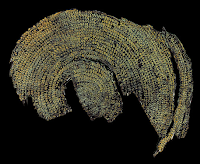Somehow I missed this important study on the Neolithic and Chalcolithic demographics of Europe, as inferred from the archaeological record (h/t Davidski):
Stephen Shennan et al., Regional population collapse followed initial agriculture booms in mid-Holocene Europe. Nature Communications 2013. Open access → LINK [doi:doi:10.1038/ncomms3486]
Abstract
Following its initial arrival in SE Europe 8,500 years ago agriculture spread throughout the continent, changing food production and consumption patterns and increasing population densities. Here we show that, in contrast to the steady population growth usually assumed, the introduction of agriculture into Europe was followed by a boom-and-bust pattern in the density of regional populations. We demonstrate that summed calibrated radiocarbon date distributions and simulation can be used to test the significance of these demographic booms and busts in the context of uncertainty in the radiocarbon date calibration curve and archaeological sampling. We report these results for Central and Northwest Europe between 8,000 and 4,000 cal. BP and investigate the relationship between these patterns and climate. However, we find no evidence to support a relationship. Our results thus suggest that the demographic patterns may have arisen from endogenous causes, although this remains speculative.
The most interesting aspect is maybe that the (apparent) demographic changes are detailed for many regions of Europe, but first let’s see the general outlook for the whole area surveyed (Western and Northern Europe, Iberia excluded):
 |
Figure 2: SCDPD-inferred population density change 10,000–4,000 cal. BP using all radiocarbon dates in the western Europe database.
Colored arrows and their annotations are mine. |
I decided that it was important to mark the main cultural episodes for reference.
1st Neolithic refers to Impressed-Cardium and Linear Band Pottery cultures, which arrived almost simultaneously to Germany and France (of the surveyed areas), although the Rhône-Languedoc Neolithic is a few centuries earlier than the arrow, which has been standardized to 7500 BP.
Atlantic Neolithic refers to the quite belated arrival of Neolithic to Britain, Ireland and Northern Europe (standardized at 6000 BP). This process was quickly followed and tightly associated with the widespread cultural phenomenon of Dolmenic Megalithism. It is most interesting that the main deviation from the pattern of regular growth concentrates in this period and is clearly positive.
Corded Ware culture (Indoeuropean consolidation in Central and Northern Europe) affected only to Germany and Denmark-Scania within the surveyed regions. It was followed by a more widespread subcultural phenomenon known as Bell Beaker, which almost invariably cases manifests within pre-existent locally rooted cultures. Neither seems to be correlated with demographic expansions in the general overview.
Now let’s take a look at the regional graphs:
 |
Figure 3: SCDPD-inferred population density change 8,000–4,000 cal. BP for each sub-region.
Colored arrows, excepted the blue ones (which mark the local first Neolithic), are mine and mark general pan-European initial chronologies (not local!) for Megalithism, Corded Ware and Bell Beaker in those regions where they had some clear influence. |
Here we can appreciate that:
Atlantic Neolithic and its associated Megalithic phenomenon are clearly related to notable demographic expansions in Ireland, Scotland, South England, Denmark and Scania. Megalithic influence may also be associated with some more irregular growth in South and Central Germany but rather not in France nor West Germany. A contemporary weak and irregular growth in North Germany (Brandenburg, Mecklemburg and Schlewig-Holstein) may be correlated with Funnelbeaker (with roots in Denmark) and the first Kurgan development of Baalberge and successor cultures (with roots in Eastern Europe), which would eventually evolve into Corded Ware.
Corded Ware only seems related to clear demographic growth in Jutland (and less resolutely in Scania). Bell Beaker is only linked with clear demographic growth in Ireland (and much more weakly in South England and Central Germany), while elsewhere it is rather associated with decline.
For the exact extension of the various regions as defined for this study, see
fig. 1 (map).
As provisional conclusion, it seems obvious to my eyes that the most important demographic growth processes were the various Neolithic cultures but that the Atlantic Neolithic (and associated Megalithism) was particularly dynamic. In contrast Indoeuropean-associated cultural phenomena had a much weaker impact, with some localized exceptions, and are generally associated with local demographic decline instead, at least judging from the archaeological record.
See also:

















